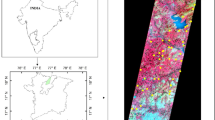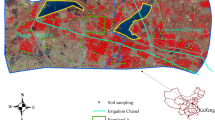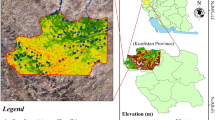Abstract
Soil nutrients are the key factors in soil fertility, which have important roles in plant growth. Determining soil nutrient contents, including macro and micronutrients, is of crucial importance in agricultural productions. Conventional laboratory techniques for determining soil nutrients are expensive and time-consuming. This research was aimed to develop linear regression (LR) models for remote sensing of total nitrogen (TN) (mg/kg), available phosphorous (AP) (mg/kg), available potassium (AK) (mg/kg), and micronutrients such as iron (Fe) (mg/kg), manganese (Mn) (mg/kg), zinc (Zn) (mg/kg), and copper (Cu) (mg/kg) extracted by DTPA in rain-fed agricultural lands in the northwest of Iran. First, 101 soil samples were collected from 0–30 cm of these lands and analyzed for selected nutrient contents. Then a linear regression along with principal component analysis was conducted to correlate soil nutrient contents with reflectance data of different Landsat OLI bands. Finally, the spatial distributions of soil nutrients were drawn. The results showed that there were linear relationships between soil nutrient contents and standardized PC1 (ZPC1). The highest significant determination coefficient with an R2 value of 0.46 and the least relative error (%) value of 11.97% were observed between TN and ZPC1. The accuracy of the other LR’s developed among other soil nutrient contents and remotely sensed data was relatively lower than that obtained for TN. According to the results obtained from this study, although remote sensing techniques may quickly assess soil nutrients, new techniques, technologies, and models may be needed to have a more accurate prediction of soil nutrients.








Similar content being viewed by others
References
Alho, C. F. B. V., Samuel-Rosa, A., Martins, G. C., Hiemstra, T., Kuyper, T. W., & Teixeira, W. G. (2019). Spatial variation of carbon and nutrients stocks in Amazonian Dark Earth. Geoderma, 337, 322–332.
Bai, X., Gao, J., Wang, S., Cai, H., Chen, Z., Zhou, J. (2020). Excessive nutrient balance surpluses in newly built solar greenhouses over five years leads to high nutrient accumulations in soil. Agriculture, Ecosystems & Environment, 288:106717.
Baig, M. B., Shahid, S. A., & Straquadine, G. S. (2013). Making rainfed agriculture sustainable through environmental friendly technologies in Pakistan: A review. International Soil and Water Conservation Research, 1(2), 36–52.
Chi, Y., Shi, H., Zheng, W., & Sun, J. (2018). Simulating spatial distribution of coastal soil carbon content using a comprehensive land surface factor system based on remote sensing. Science of the Total Environment, 628, 384–399.
Coppin, P., Jonckheere, I., Nackaerts, K., Muys, B., & Lambin, E. (2004). Review Article Digital change detection methods in ecosystem monitoring: A review. International Journal of Remote Sensing, 25(9), 1565–1596.
Gabriel, K. R. (1971). The biplot graphic display of matrices with application to principal component analysis. Biometrika, 58(3), 453–467.
Gökkaya, K., Thomas, V., Noland, T. L., McCaughey, H., Morrison, I., & Treitz, P. (2015). Prediction of macronutrients at the canopy level using spaceborne imaging spectroscopy and LiDAR data in a mixedwood boreal forest. Remote Sensing, 7(7), 9045–9069.
Goulding, K., Jarvis, S., & Whitmore, A. (2008). Optimizing nutrient management for farm systems. Philosophical Transactions of the Royal Society B: Biological Sciences, 363(1491), 667–680.
Gras, J.-P., Barthès, B. G., Mahaut, B., & Trupin, S. (2014). Best practices for obtaining and processing field visible and near infrared (VNIR) spectra of topsoils. Geoderma, 214, 126–134.
Hahs-Vaughn, D. L. (2016). Applied multivariate statistical concepts. Taylor & Francis.
Hengl, T., Leenaars, J. G., Shepherd, K. D., Walsh, M. G., Heuvelink, G. B., Mamo, T., Tilahun, H., Berkhout, E., Cooper, M., & Fegraus, E. (2017). Soil nutrient maps of Sub-Saharan Africa: Assessment of soil nutrient content at 250 m spatial resolution using machine learning. Nutrient Cycling in Agroecosystems, 109(1), 77–102.
Iranian soil and water institute. (1991). http://www.swri.ir/
Irshad, M., Inoue, M., Ashraf, M., Delower, H. K., & Tsunekawa, A. (2007). Land desertification-An emerging threat to environment and food security of Pakistan. Journal of Applied Sciences, 7(8), 1199–1205.
Jackson, M. (1973). Soil chemical analysis (Indian). Prentice Hall of India Pvt. Ltd.
Keshavarzi, A., Sarmadian, F., Omran, E.-S.E., & Iqbal, M. (2015). A neural network model for estimating soil phosphorus using terrain analysis. The Egyptian Journal of Remote Sensing and Space Science, 18(2), 127–135.
Kosheleva, N. E., Vlasov, D. V., Korlyakov, I. D., & Kasimov, N. S. (2018). Contamination of urban soils with heavy metals in Moscow as affected by building development. Science of the Total Environment, 636, 854–863.
Li, J., Ma, X., Zhang, C. (2020). Predicting the spatiotemporal variation in soil wind erosion across Central Asia in response to climate change in the 21st century. Science of The Total Environment, 709:136060.
Lindsay, W. L., & Norvell, W. A. (1978). Development of a DTPA soil test for zinc, iron, manganese, and copper. Soil Science Society of America Journal, 42(3), 421–428.
Liu, X., Ma, J., Ma, Z.-W., & Li, L.-H. (2017). Soil nutrient contents and stoichiometry as affected by land-use in an agro-pastoral region of northwest China. CATENA, 150, 146–153.
Lv, Y., & Li, B. (2006). Pedology, Agriculture Press.
Minasny, B., Finke, P., Stockmann, U., Vanwalleghem, T., & McBratney, A. B. (2015). Resolving the integral connection between pedogenesis and landscape evolution. Earth-Science Reviews, 150, 102–120.
Minasny, B., & McBratney, A. B. (2006). Mechanistic soil–landscape modelling as an approach to developing pedogenetic classifications. Geoderma, 133(1–2), 138–149.
Nam, J., Chang, W., & Kang, D. (2010). Carrying capacity of an uninhabited island off the southwestern coast of Korea. Ecological Modelling, 221(17), 2102–2107.
Nelson, D. W., Sommers, L. E. (1996). Total carbon, organic carbon, and organic matter. Methods of soil analysis: Part 3 Chemical methods, 5, 961–1010.
Olsen, S. R. (1954). Estimation of available phosphorus in soils by extraction with sodium bicarbonate. vol 939. US Department of Agriculture.
Rahmati, M., & Hamzehpour, N. (2018). Effectiveness of spectral data reduction in detection of salt-affected soils in a small study area. Desert, 23(1), 97–106.
Raj, A., Chakraborty, S., Duda, B. M., Weindorf, D. C., Li, B., Roy, S., Sarathjith, M., Das, B. S., & Paulette, L. (2018). Soil mapping via diffuse reflectance spectroscopy based on variable indicators: An ordered predictor selection approach. Geoderma, 314, 146–159.
Sinfield, J. V., Fagerman, D., & Colic, O. (2010). Evaluation of sensing technologies for on-the-go detection of macro-nutrients in cultivated soils. Computers and Electronics in Agriculture, 70(1), 1–18.
Smith, W. K., Dannenberg, M. P., Yan, D., Herrmann, S., Barnes, M. L., Barron-Gafford, G. A., Biederman, J. A., Ferrenberg, S., Fox, A. M., Hudson, A. (2019). Remote sensing of dryland ecosystem structure and function: Progress, challenges, and opportunities. Remote Sensing of Environment, 233, 111401.
Song, X.-D., Brus, D. J., Liu, F., Li, D.-C., Zhao, Y.-G., Yang, J.-L., & Zhang, G.-L. (2016). Mapping soil organic carbon content by geographically weighted regression: A case study in the Heihe River Basin. China. Geoderma, 261, 11–22.
Song, Y.-Q., Zhao, X., Su, H.-Y., Li, B., Hu, Y.-M., & Cui, X.-S. (2018). Predicting spatial variations in soil nutrients with hyperspectral remote sensing at regional scale. Sensors, 18(9), 3086.
Tao, Y., Zhou, X.-B., Zhang, S.-H., Lu, H.-Y., Shao, H. (2020). Soil nutrient stoichiometry on linear sand dunes from a temperate desert in Central Asia. Catena, 195:104847.
Tavakoli, M. T., Chenari, A. I., Rezaie, M., Tavakoli, A., Shahsavari, M., & Mousavi, S. R. (2014). The importance of micronutrients in agricultural production. Advances in Environmental Biology, 1, 31–36.
Voss, R. (1998). Micronutrients. Iowa State University, Department of Agronomy, USA Available at [Access date: 0202 2017]: agronext iastate edu.
Wang, S., Jin, X., Adhikari, K., Li, W., Yu, M., Bian, Z., & Wang, Q. (2018). Mapping total soil nitrogen from a site in northeastern China. CATENA, 166, 134–146.
Whitehead, D., Schipper, L. A., Pronger, J., Moinet, G. Y., Mudge, P. L., Pereira, R. C., Kirschbaum, M. U., McNally, S. R., Beare, M. H., & Camps-Arbestain, M. (2018). Management practices to reduce losses or increase soil carbon stocks in temperate grazed grasslands: New Zealand as a case study. Agriculture, Ecosystems & Environment, 265, 432–443.
Xu, Y., Smith, S. E., Grunwald, S., Abd-Elrahman, A., Wani, S. P., & Nair, V. D. (2018). Estimating soil total nitrogen in smallholder farm settings using remote sensing spectral indices and regression kriging. CATENA, 163, 111–122.
Yan, T., Lü, X.-T., Zhu, J.-J., Yang, K., Yu, L.-Z., & Gao, T. (2018). Changes in nitrogen and phosphorus cycling suggest a transition to phosphorus limitation with the stand development of larch plantations. Plant and Soil, 422(1–2), 385–396.
Author information
Authors and Affiliations
Corresponding author
Additional information
Publisher's Note
Springer Nature remains neutral with regard to jurisdictional claims in published maps and institutional affiliations.
Rights and permissions
About this article
Cite this article
Miran, N., Rasouli Sadaghiani, M.H., Feiziasl, V. et al. Predicting soil nutrient contents using Landsat OLI satellite images in rain-fed agricultural lands, northwest of Iran. Environ Monit Assess 193, 607 (2021). https://doi.org/10.1007/s10661-021-09397-0
Received:
Accepted:
Published:
DOI: https://doi.org/10.1007/s10661-021-09397-0




